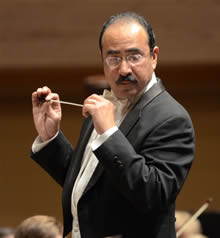Nrityagram Dance Ensemble performed in Reynolds Theater following a three-day residency with Duke Dance, in a concert presented by Duke Performances and co-sponsored by the Indian Classical Music and Dance Society. Perhaps they had given too much of their energy to the students during the residency: the concert was very low wattage compared to the luminosity of Nrityagram’s previous Triangle appearances, in 2003 and 2008. Surupa Sen and Bijayini Satpathy are two of the most beautiful dancers in any style working today, and there were many beautiful moments in five linked dance-stories, but the performance as a whole lacked the electric vitality of those seen previously.
“Songs of Love and Longing” derives from the Gita Govinda, a 12th century Sanskrit ballad about the immortal love between Radha and Krishna, about the irresistible pull toward wholeness of the perpetually separated lovers. Its story is a metaphor for the longing of the individual to merge with the boundless infinite. The songs of the Gita Govinda and their performance in music and dance pantomime remain part of worship in Orissa temples.
The temple was indicated on the Reynolds stage by a glowing decorated altar, at which the first dancer, Bijayini Satpathy, laid an offering. From off-stage came the voice of Surupa Sen, giving an English translation of the text while Satpathy showed the stylized gestures and actions representing the words before the four musicians onstage began the song and she began the dance expressing Radha’s longing for Krishna. This method of familiarizing the viewers with the dance vocabulary is highly effective, being pleasing in and of itself, and was used in each of the five dances.
But as exquisite as Satpathy is in form and motion, sparks did not fly. Even the musicians seemed muted, and the stage pictures were blurred by the strange excess of theatrical smoke. The second dance, in which Sen, as Radha’s friend, joined Satpathy, was the strongest of the evening. To my eye, Sen is a shade more magnificent a dancer, with her glorious counterbalanced S-curves, pure lines, and the made-for-the-stage scale of her face, but Satpathy’s liquidity of motion is matchless.
Radha’s mad with desire and jealousy; her friend brings the news that Krishna awaits, urging Radha to go to him. They turn and whirl, ankle bells chiming, gold and red silks swirling, until Radha’s jealousy fades and sweet hopeful desire propels her to the sacred grove.
Naturally, Krishna is not waiting. This time, Sen dances Radha, sorrowful and deceived. In the next dance, Satpathy embodies Krishna, cajoling and complimenting. The final dance is another duet. The two come together, with the nut of the philosophy: “I am faithful now, Radha. There is but this moment. Make me yours!”
“There is but this moment” could be the tagline for every dance that ever was, is or will be. As in life, not every moment is as wonderful as it might be. But we go on longing, like Radha, for transcendence.











